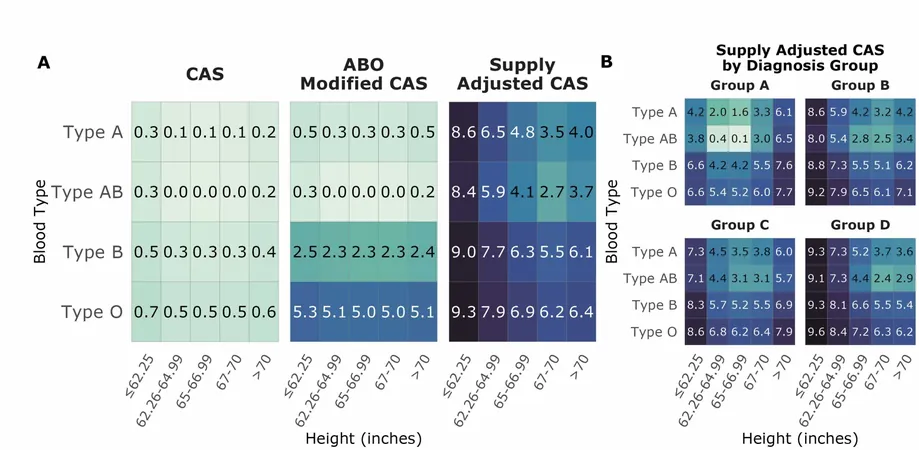
Groundbreaking Scoring System Promises Fairer Access to Lung Transplants for All!
2024-10-15
Author: Jacob
Introduction
A pioneering study from the Cleveland Clinic and Case Western Reserve University (CWRU) has unveiled a revolutionary new scoring method aimed at leveling the playing field for candidates in urgent need of lung transplants, particularly those whose unique characteristics may limit their chances of receiving a suitable donor organ.
Disparities in Access
Recent findings published in the Journal of Heart & Lung Transplantation reveal alarming disparities in access to lung transplants based on crucial factors like blood type and height. Currently, transplant candidates in the U.S. are assessed through a Composite Allocation Score, which incorporates a biological disadvantage subscore designed to lend additional support to individuals with shorter heights and less common blood types. However, this approach has been criticized for its inadequacies in fully addressing the inequities faced by certain candidates.
Innovative Scoring Model
The research team, leveraging extensive data on adult lung transplant candidates and donors nationwide, has devised an innovative scoring model that addresses the limitations of the existing system. Their method assesses the potential supply of compatible organs available for candidates based on their specific blood type and height combinations. This holistic evaluation could transform the daunting experience of waiting for a transplant, providing candidates with a fairer chance of success.
Expert Insights
Dr. Maryam Valapour, a pulmonologist at Cleveland Clinic and co-senior author of the study, stated, "This new approach has the potential to significantly decrease mortality on the organ waitlist while simultaneously increasing the overall transplant rates." Dr. Jarrod Dalton, co-senior author and researcher, emphasized that their methodology takes into account the compounding disadvantages that candidates face, especially those with rare blood types or unique height profiles.
Type-O Blood Candidates
A glaring example is the challenge encountered by candidates with type-O blood. While these individuals can only receive organs from type-O donors, the reverse is not true—type-O organs are compatible with all blood types. The study highlighted that under the current allocation system, type-O candidates face a staggering 37% lower transplant rate compared to type-A candidates when adjusting for height and medical urgency.
Height Disparities
Height disparities also play a crucial role in the likelihood of receiving a transplant, as the availability of donor organs that match a candidate's size significantly impacts surgical feasibility. For instance, research indicated that a candidate who stands at 5'9" enjoys a 61% higher chance of receiving a transplant than someone who is 5'3". This trend underscores a troubling sex disparity in lung transplants, with women generally being shorter and consequently facing additional challenges.
Call to Action
Looking forward, Dr. Johnie Rose, an associate professor at CWRU and co-first author of the research, urged policymakers to prioritize addressing these notable height and blood type disparities, emphasizing that progress in this area is essential for achieving equitable access to lung transplants across the United States. "We have a duty to ensure every candidate receives fair consideration, regardless of their biological traits," he stated.
Future Directions
As the researchers prepare to fine-tune the weighting of the components within the Composite Allocation Score, there lies hope that this groundbreaking approach will not only benefit lung transplant candidates but could eventually be adapted for other organ transplantation allocations.
Conclusion
This significant advancement in lung transplant methodology raises the question: Could this be the key to a more equitable future in organ donation? Stay tuned as we follow the progress of this vital research that aims to save countless lives!









 Brasil (PT)
Brasil (PT)
 Canada (EN)
Canada (EN)
 Chile (ES)
Chile (ES)
 España (ES)
España (ES)
 France (FR)
France (FR)
 Hong Kong (EN)
Hong Kong (EN)
 Italia (IT)
Italia (IT)
 日本 (JA)
日本 (JA)
 Magyarország (HU)
Magyarország (HU)
 Norge (NO)
Norge (NO)
 Polska (PL)
Polska (PL)
 Schweiz (DE)
Schweiz (DE)
 Singapore (EN)
Singapore (EN)
 Sverige (SV)
Sverige (SV)
 Suomi (FI)
Suomi (FI)
 Türkiye (TR)
Türkiye (TR)